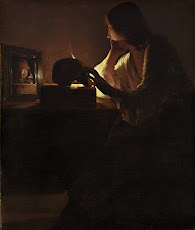Georges de La Tour's Mary Magdalene Paintings
The Magdalen
Rather than focusing on a single artwork in this analysis, I will be covering a series of paintings from the artist Georges de La Tour that cover a similar subject. Below as pictured are The Repentant Magdalen, The Penitent Magdalen, and The Magdalen with the Smoking Flame respectively.
The similarities in these painting is immediately evident in both name and visual aspects. Georges de La Tour painted these four figurative painting at relatively the same time, between 1635 and 1640. Each one of these pieces depicts Mary Magdalene, one of Jesus's disciples and witness to his resurrection according to the Bible. However, unlike the majority of representations of Mary Magdalene, La Tour chose to depict her alone, and not in direct relation to Jesus. This stark change of subject along with certain Baroque elements mark this piece in relation to the Council Trent. The relation to the the Council of Trent becomes evident when viewing the propagandistic approach that the council took towards religious artworks. The goal of the Council of Trent was to oppose the Reformation by creating digestible religious artwork to be seen and taken in by commoners. In this way, religious depictions became more realistic and prominent as can be seen in La Tour's three paintings of Mary.
As for the baroque elements present in these paintings, contrast is one of the strongest elements. The human eye is naturally drawn to the highest point of contrast due to instincts and baroque era artworks take advantage of this. The three paintings of Mary Magdalene all contain a candle as the only light source, with Mary facing the direction of it. The dramatic mood lighting of candles lends itself to the strong contrasts in dark shadows and the bright flame of the candle itself. Besides the element of contrast, realism is very prevalent, with accurate depictions of proportional items and the anatomical figure of Mary. Another baroque element at hand in these three paintings are the items representing the fleeting nature of life. The skull that Mary rests her hand upon in The Repentant Magdalen and The Penitent Magdalen and carries in her lap in The Magdalen with the Smoking Flame is a consistent theme and a strong symbol of death and transience. Items like the candle and mirror also hold similar, while less jarring, messages.
As compared to depictions of Mary Magdalene in the Renaissance, the baroque depictions by Georges de La Tour are far more realistic and dramatic, making them more receptive to commoners. Below is a Renaissance era depiction titled Saint Mary Magdalene by Bernardino Luini.
Works Cited
“The Repentant Magdalen.” National Gallery of Art, www.nga.gov/collection/art-object-page.54386.html. Accessed 11 Oct. 2024.
“The Penitent Magdalen.” Metmuseum.org, 2020, www.metmuseum.org/art/collection/search/436839. Accessed 11 Oct. 2024.
“From the Collection: The Magdalen with the Smoking Flame | Unframed.” Unframed.lacma.org, unframed.lacma.org/2015/04/06/collection-magdalen-smoking-flame. Accessed 11 Oct. 2024.
“Saint Mary Magdalene.” The Walters Art Museum, art.thewalters.org/detail/37520/mary-magdalen/. Accessed 11 Oct. 2024.






I agree with your thought that Georges de La Tour's paintings of Mary Magdalen have a broader appeal thanks to the baroque period's transition away from grand religious scenes and move towards more intimate, darker imagery. The darkness of the pieces you selected really appeal to me as well as the simplicity of Magdalen's surroundings. I think the artist's heavy use of tenebrism really adds to the depressing tone of the images. Thanks for sharing!
ReplyDelete